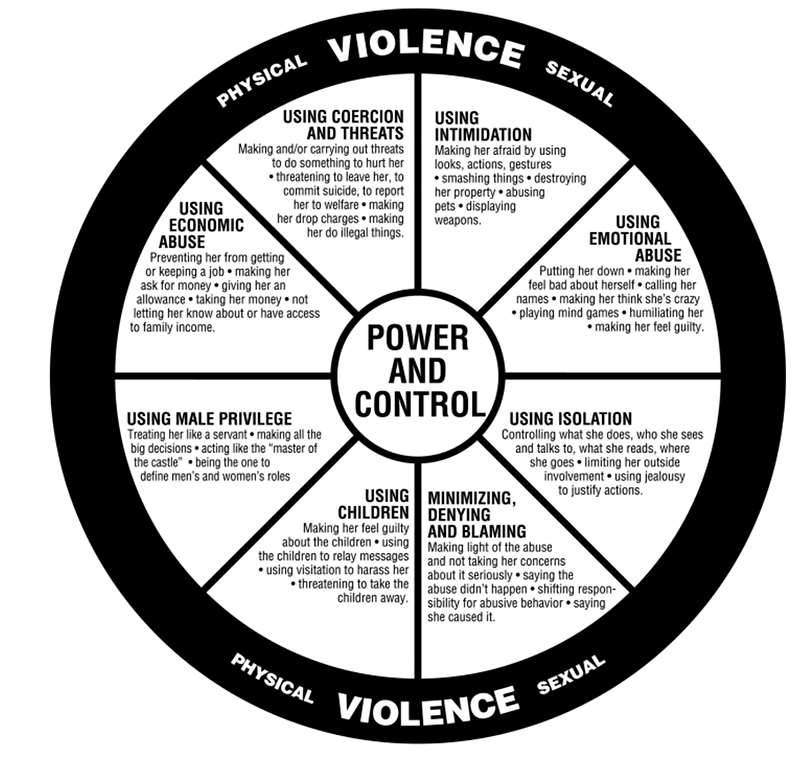Interpersonal Violence
What is interpersonal violence?
»» RAINN.org
»» The National Domestic Violence Hotline
Interpersonal violence: An umbrella term that includes all forms of sexual and relationship violence.
Sexual Assault
Actual or attempted sexual contact with another person without that person’s consent. Some forms of sexual assault include rape, unwanted touching or fondling, or forcing the victim to perform any type of sexual act without consent.
Rape
A form of sexual assault, but not all sexual assault is rape. The term rape is often used as a legal definition to specifically include sexual penetration without consent. For its Uniform Crime Reports, the FBI defines rape as “penetration, no matter how slight, of the vagina or anus with any body part or object, or oral penetration by a sex organ of another person, without the consent of the victim.”
Sexual Harassment
Sexual harassment includes unwelcome sexual advances, requests for sexual favors, and other verbal or physical harassment of a sexual nature in the workplace or learning environment, according to the Equal Employment Opportunity Commission (EEOC). Sexual harassment does not always have to be specifically about sexual behavior or directed at a specific person. For example, negative comments about women as a group may be a form of sexual harassment. Sexual harassment interferes with your performance by threatening your job security or becoming an obstacle to effective work.
Sexual harassment can occur in a variety of circumstances. The harasser can identify with any gender and have any relationship to the victim, including being a direct manager, indirect supervisor, co-worker, teacher, peer, or colleague.
Some forms of sexual harassment include:
- Making conditions of employment dependent on sexual favors
- Physical acts of sexual assault
- Requests for sexual favors
- Verbal harassment of a sexual nature
- Unwanted touching or physical contact
- Unwelcome sexual advances
Force/Coercion
Force does not always refer to physical pressure. Perpetrators may use emotional coercion, psychological force, or manipulation to coerce a victim into non-consensual sex. Some perpetrators will use threats to force a victim to comply, such as threatening to hurt the victim or their family or other intimidation tactics.
Intimate Partner Violence
Also called domestic violence, domestic abuse or relationship abuse, is a pattern of behavior used by one partner to maintain power and control over another partner in an intimate relationship.
Intimate Partner Violence does not discriminate. Anyone of any race, age, sexual orientation, religion or gender can be a victim – or perpetrator – of domestic violence. It can happen to people who are married, living together or who are dating. It affects people of all socioeconomic backgrounds and education levels.
Domestic violence includes behaviors that physically harm, arouse fear, prevent a partner from doing what they wish or force them to behave in ways they do not want. It includes the use of physical and sexual violence, threats and intimidation, emotional abuse and economic deprivation.

218-722-2781
Stalking
Stalking is a pattern of repeated and unwanted attention, harassment, contact, or any other course of conduct directed at a specific person that would cause a reasonable person to feel fear. Stalking behavior can include the following:
- Making threats against someone, or that person's family or friends
- Non-consensual communication, such as repeated phone calls, emails, text messages, and unwanted gifts
- Repeated physical or visual closeness, like waiting for someone to arrive at certain locations, following someone, or watching someone from a distance
- Any other behavior used to contact, harass, track, or threaten someone
Stalking with technology or “cyberstalking” is becoming more common in our society. Examples of this include:
- Persistently sending unwanted communication through the internet, such as spamming someone’s email inbox or social media platform
- Posting threatening or personal information about someone on public internet forums
- Video-voyeurism, or installing video cameras that give the stalker access to someone’s personal life
- Using GPS or other software tracking systems to monitor someone without their knowledge or consent
- Using someone’s computer and/or spyware to track their computer activity
Strangulation
Strangulation is often incorrectly referred to as choking. It is important to know the differences between the two, because strangulation can have long-lasting negative consequences to the body and brain. Choking is defined as having difficulty breathing due to a constricted or obstructed throat or lack of air. An object is stuck within the throat or mouth, keeping the person from breathing. Strangulation is defined as the act in which circulation of blood to a part of the body is cut off by constriction. This can be done by applying pressure on the throat/neck or by blocking airflow to the nose and mouth.
It is important to know the difference between terminology due to the severity of strangulation. Even a small amount of pressure to the throat or neck can cause significant brain damage. Some states define strangulation as attempted murder. In 2017, Bill SB153 was passed in the state of Montana to consider strangulation a felony offense.
Strangulation is a significant predictor for future lethal violence. If your partner has strangled you in the past, your risk of being killed by them is 10 times higher. Strangulation is one of the most lethal forms of domestic violence. Unconsciousness may occur within seconds and death within minutes.
Emotional Abuse
Like physical abuse, emotional abuse is an attempt to control another person. The only difference is that the emotional abuser does not use physical hitting, kicking, pinching, grabbing, pushing, or other physical
forms of harm. Rather the perpetrator of emotional abuse uses emotion as his/her weapon of choice. Emotional abuse can present as:
- Constant criticism, lying, manipulation, and control
- Shaming and blaming, using belittling language
- Name calling
- Withholding affection as punishment, known as silent treatment
- Threats of physical abuse to you or someone you know, even a pet
- Gaslighting
- Isolating the individual from friends and family
- Perpetrator threatening to harm themselves (even suicide) if the survivor leaves

